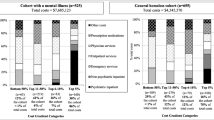Abstract
We examined the prevalence of, and factors associated with unmet health service needs among persons with HIV disease. Data were examined from 1,851 participants in the U.S. AIDS Cost and Service Utilization Study, drawn from 26 medical care providers in 10 cities. Geographic areas with large numbers of AIDS cases, and health care providers within them were chosen as study sites. After completing a screener questionnaire, potential participants at each site were stratifed by illness stage, HIV exposure route, and insurance status; a systematic random sample within those strata were selected for the study. Participants completed a comprehensive survey of HIV-related service use and costs, which also asked them to identify unmet health service needs. Analyses identified the relationship between unmet needs and: stage of illness, type of insurance, source of care, living arrangement, and AIDS prevalence of respondents' geographic region. At least one unmet need was reported by 20% of the sample. Needs for non-institutional services, e.g., dental care, mental health, and medications were more likely to be unmet than need for emergency room and hospital care. While most factors significantly affected the odds of having an unmet need, the greatest effects were found for private insurance and HIV asymptomatic status, both of which decreased the odds of unmet needs by approximately 50%. These findings suggest that insurance coverage for services required during the chronic phase of HIV illness is inadequate and should be augmented.
Similar content being viewed by others
References
Centers for Disease Control.MMWR HIV prevalence estimates and AIDS case projections for the United States: Report based upon a workshop. November 1990. Vol. 39/No. RR-16.
Piette JD, Fleishman J, Stein MD, et al. Prevalence of service needs and unmet needs among persons with HIV disease.J Community Health. 1993; 18: 11–23.
National Association of People with AIDS. HIV in America: A report by the National Association of People with AIDS. Washington D.C., September 1992.
Crystal S and Jackson MM. Psychosocial adaptation and economic circumstances of persons with AIDS and ARC.Fam Community Health. 1989; 12: 77–88.
Moore RD, Hidalgo J, Sugland BW, Chaisson RE. Zidovudine and the natural history of the Acquired Immunodeficiency Syndrome.N Engl J Med. 1991; 324: 1412–1416.
Stein MD, Piette MS, Mor V, et al. Differences in access to Zidovudine (AZT) among symptomatic HIV-infected persons.J Gen Intern Med. 1991; 6: 35–40.
McCormick WC, Inui T, Deyo RA, and Wood R. Long term care needs of hospitalized persons with AIDS: A prospective cohort study.J Gen Intern Med. 1991; 6: 27–34.
Amory J, Werderger D, Rutherford G. AIDS in San Francisco: Status report for fiscal 1987 and projections of service needs and costs for 1988–1993. San Francisco: San Francisco Department of Health. April 22, 1988.
State of New York. AIDS, New York's Response: A 5-year interagency plan. Albany, New York. January 1989.
Guydish J, Temoshok L, Dilley J, Rinaldi J. Evaluation of a hospital based substance intervention and referral service for HIV affected patients.Gen Hosp Psychiatry. 1990; 12: 1–7.
Piette JD, Mor V, Mayer K, Zierler S, Wachtel T. The effects of immune status and race on health service use among people with HIV disease.Am J Public Health. 1993; 83: 510–514.
Solomon L, Frank R, Vlahov D, Astemborski J. Utilization of health services in a cohort of intravenous drug users with known HIV-1 serostatus.Am J Public Health. 1991; 81: 1285–1290.
Dutton D. Financial, organizational and professional factors affecting health care utilization.Soc Sci Med. 1986; 23: 721–735.
Cornelius L, Beauregard K, and Cohen J.National medical expenditure survey: Usual sources of care and their characteristics. Research Findings 11. Agency for Health Care Policy and Research. Rockville, Maryland, 1991.
Berkman LF. Assessing the physical effects of social networks and social support. Pp. 413–432. InAnnual Review of Public Health, edited by Breslow L, Fielding JE and Lave LB. Palo Alto, California; Annual Review, 1984.
Greenley JR. Sociocultural and psychological aspects of utilization of health services. In Brenner HM, Mooney A and Nagy TJ (Eds.).Assessing the contributions of the Social Sciences to Health. Boulder, Colorado: Westview Press, 1980.
Navarro M. Where AIDS is a stranger: 11 years into the epidemic few outside urban areas find support or help.New York Times. February 25, 1992: B-1.
Smith JE, Landau CSJ, Bahr G. AIDS in rural and small town America.AIDS Patient Care. 1990; June 17–21.
Berk ML, Maffeo C, Schur CL. Research design and analysis objectives. AIDS Cost and Services Utilization Survey (ACSUS) Reports, No. 1. AHCPR Pub. No. 93-0019. Rockville, MD: Agency for Health Care Policy and Research, 1993.
Under certain circumstances, herpes and candidiasis meet the CDC definition for AIDS, but not enough information was available from the screener to allow these individuals to be classified as having AIDS.
Centers for Disease Control.HIV/AIDS Surveillance. March 1992.
Centers for Disease control.HIV/AIDS Surveillance. December 1989.
Piette JD, Fleishman J, Stein MD, et al. Prevalence of service needs and unmet needs among persons with HIV disease.J Community Health. 1993; 18: 11–23.
Crystal S and Jackson MM. Psychosocial adaptation and economic circumstances of persons with AIDS and ARC.Fam Community Health. 1989; 12: 77–88.
National Association of People with AIDS. HIV in America: A report by the National Association of People with AIDS. Washington D.C., September 1992.
Schwartz B. The social ecology of time barriers.Social Forces. 1978; 56: 1203–1220.
New York State Department of Health. Request for applications for the planning and development of HIV Special Needs Plans. August 1, 1995.
Fisher I, Fein EB. Forced marriage of Medicaid and managed care hits snags.New York Times. 28 August 1995: B1.
FitzGerald CH. Emergency room habit.New York Times. 31 August 1995: A24.
Author information
Authors and Affiliations
Additional information
This study was conducted under a subcontract with Westat Inc.
Rights and permissions
About this article
Cite this article
Bonuck, K.A., Arno, P.S., Green, J. et al. Self-perceived unmet health care needs of persons enrolled in hiv care. J Community Health 21, 183–198 (1996). https://doi.org/10.1007/BF01557998
Issue Date:
DOI: https://doi.org/10.1007/BF01557998




